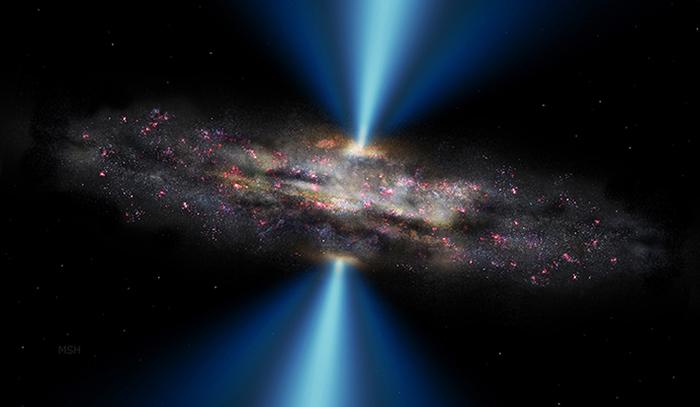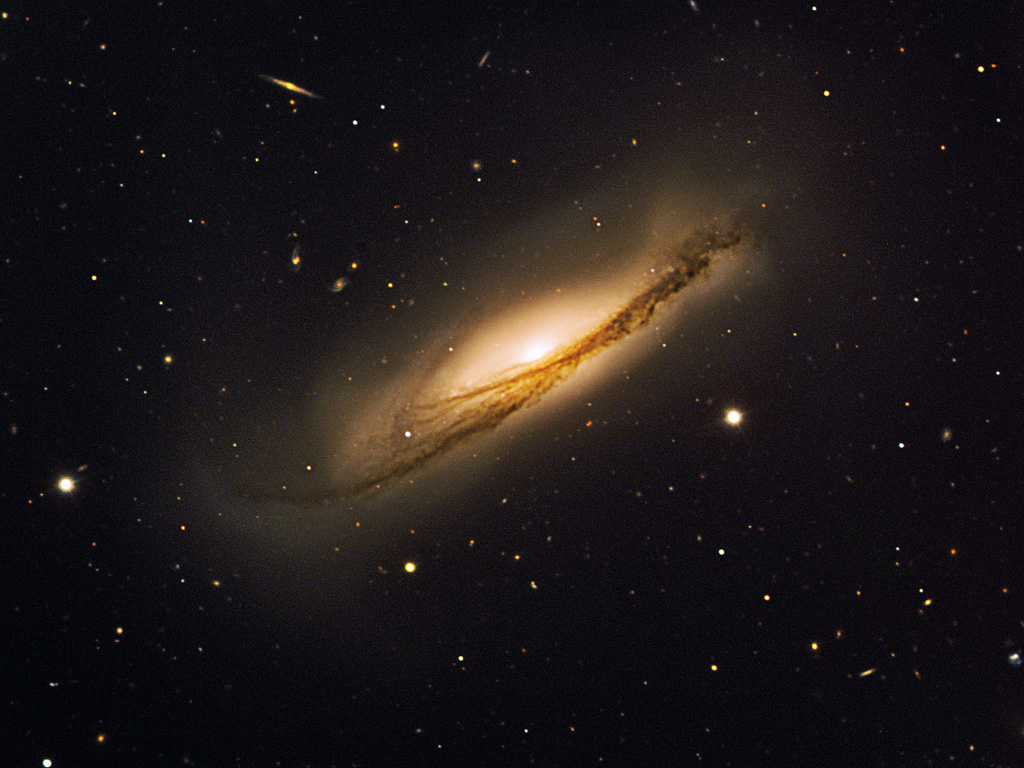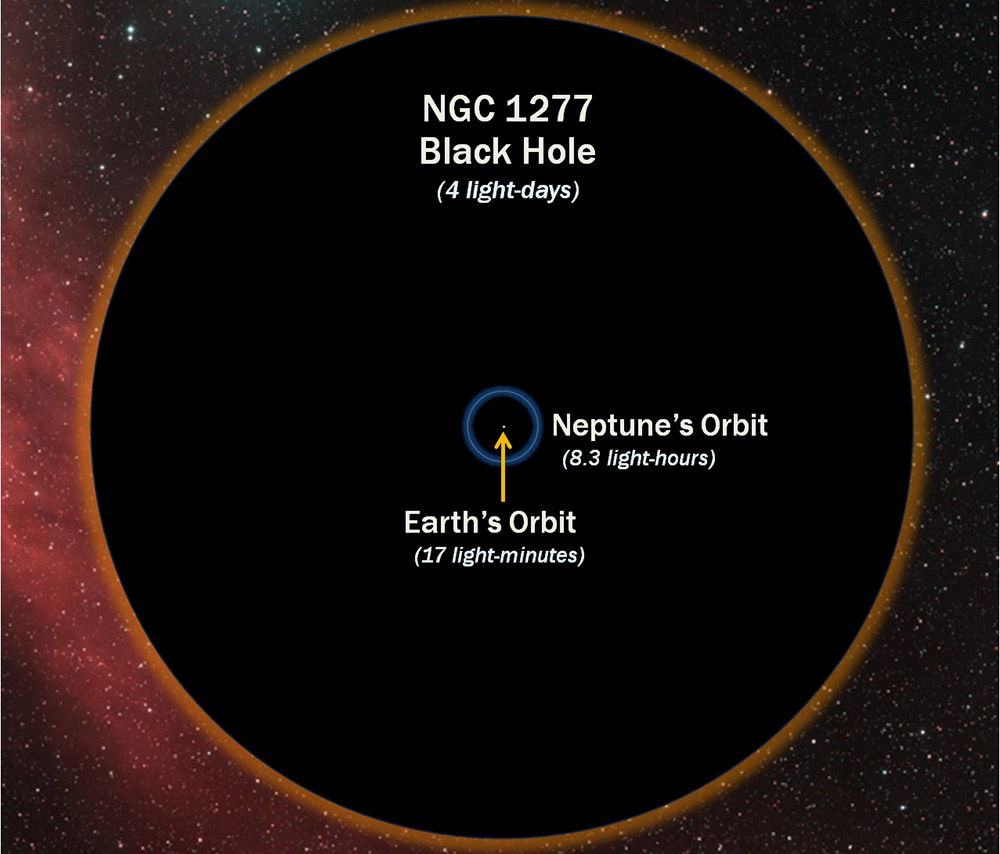

When we peer into the heart of galaxies in our local universe, we find that the vast majority harbor supermassive black holes in their centers—a trend that appears to hold steady regardless of where we look. In fact, astronomers estimate that nearly all large galaxies—ellipticals and spirals alike—have them, and they play an important role in galaxy evolution.
However, since black holes can not be seen directly (we study how they interact with their surroundings to infer their existence) it is sometimes difficult to truly ascertain how supermassive black holes shape host galaxies. Conventional wisdom says that galaxies grow and evolve alongside their supermassive black holes, but, in an odd twist, an international team of researchers have reportedly discovered a distant supermassive black hole that outgrew its host galaxy long ago.
We are seeing the unlikely pair as they were approximately 11 billion years ago, when the universe was just 2 billion years old. Back then, things were much different. The expansion of the universe hadn’t yet carried galaxies clear across billions of light-years of spacetime, and the intergalactic medium was very rich—filled with plenty of materials for black holes to feed on, and grow.
In order to make this discovery, astronomers utilized the COSMOS Legacy Survey and MOSFIRE—a new infrared spectrometer from Keck. The idea was to survey black hole growth across all walks of space and time, but they got more than they bargained for. One of the study’s co-authors, C. Megan Urry (from Yale University), expands,
“Our survey was designed to observe the average objects, not the exotic ones,” she continued, “This project specifically targeted moderate black holes that inhabit typical galaxies today. It was quite a shock to see such a ginormous black hole in such a deep field.”

Called CID-947, the galaxy’s supermassive black hole weighs around 7 billion solar masses (meaning it is heavier than 7 billion Suns combined), and joins the ranks of the heaviest supermassive black holes presently cataloged. The galaxy, on the other hand, is where things get interesting.
The researchers explain that, when coming up with an estimate for its mass, they were surprised to learn that “the measurements correspond to the mass of a typical galaxy.” In other words, the black hole is disproportionate to its host galaxy. Rather, it’s simply gargantuan in comparison.
WATCH: “6 of the Largest Objects in the Known Universe”

“Most galaxies, including our own Milky Way, have a black hole at their center, holding millions to billions of solar masses,” Yale University notes in their press release.” Not only does the new study challenge previous notions about the way host galaxies grow in relation to black holes, it also challenges earlier suggestions that the radiation emitted by expanding black holes curtails the creation of stars.”
Despite the black hole’s insatiable appetite for gas and dust—the very materials that accumulate, and eventually collapse to form new stars—CID-947 continues to churn out many new stars. There’s no signs of it slowing down either.
Ultimately, the team posits that the phenomena driving CID-947’s growth may be linked to certain starburst galaxies in our cosmic neighborhood—NGC 1277 included. This galaxy, which lurks 220 million light-years from Earth toward the Perseus constellation, is extreme in every sense of the word, especially where its central black hole is concerned. It is believed to weigh approximately 17 billion solar masses, which, if correct, would account for well over 14 percent of the entire galaxy’s mass.

“But if so, they said, the growth of the black hole still greatly anticipated the growth of the surrounding galaxy, contrary to what astronomers thought previously.”
We know that there are both upper and lower limits to how large a star or a planet can be, before it goes outside of its typical classification. Until the last few years, however, we weren’t sure if black holes abide by the same standards (I mean, we already know that black holes can be mind bendingly small). A team of researchers from Yale University set out uncover evidence for one side or the other, with conflicting results.
Their research indicated that after a certain period, the growth of the most massive black holes begins to stall, with them eventually “powering off.” Actually, it might be more precise to say they self-destruct. No matter the epoch, once black holes acquire the mass of about ten billion suns, they no longer seem to grow. The reason for this may lie in the unquantifiable amount of energy they radiate. They eventually become so large and strong that they eat away at their food source (like the gas and dust that circle the event horizon, or gather in the accretion disk).
This sounds reasonable until you consider the fact that astronomers have since come to the realization that ultramassive black holes are MUCH larger than we originally expected them to be, which might mean that there is no upper-limit. Black holes may simply never stop growing.